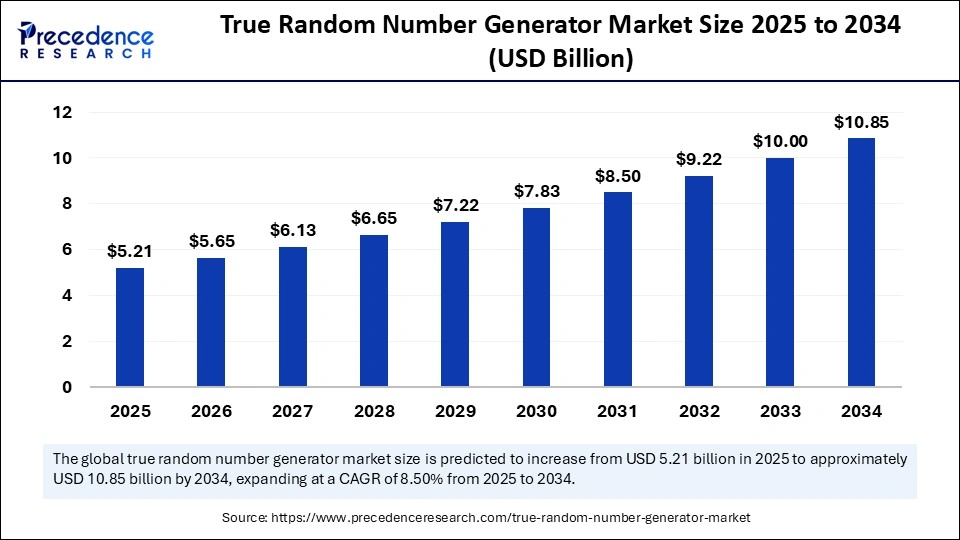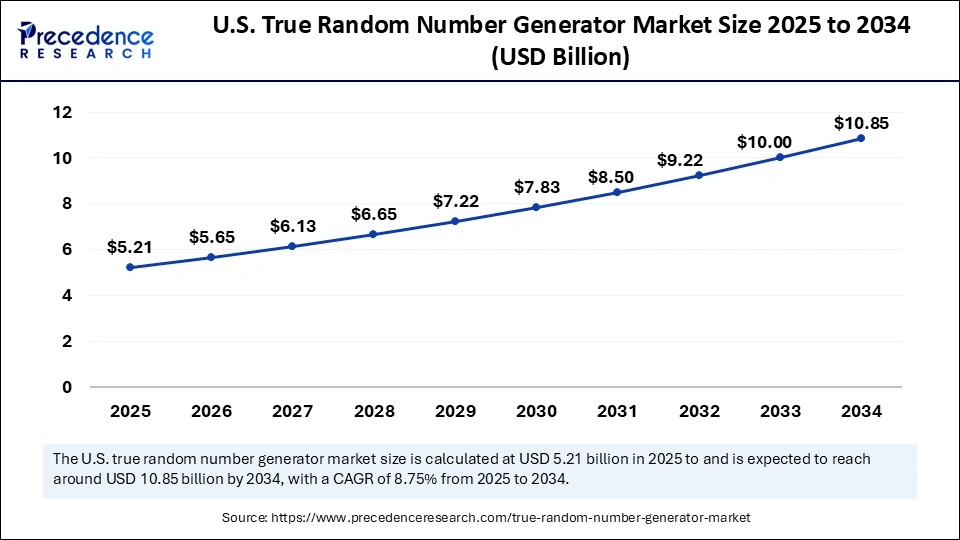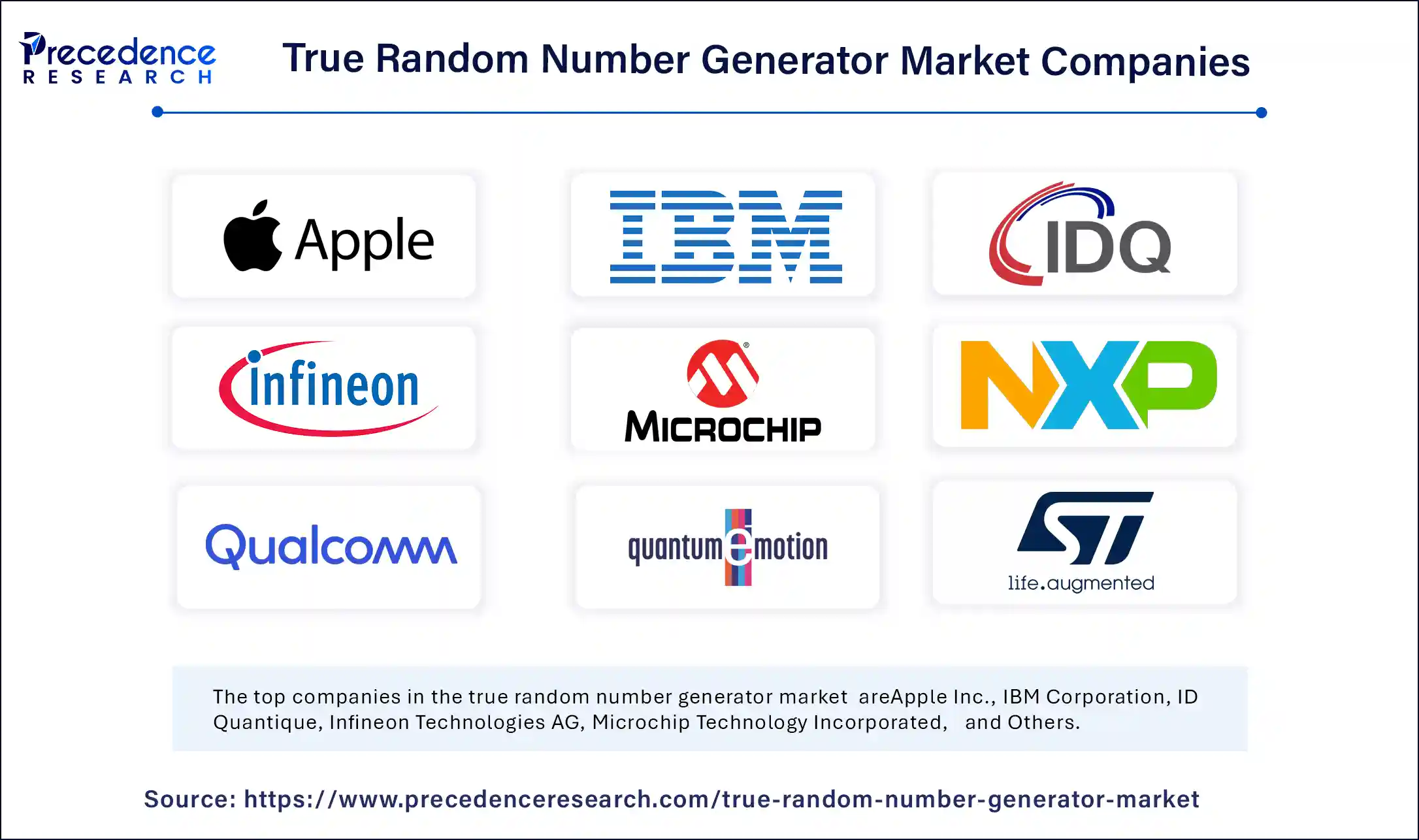List of Contents
True Random Number Generator Market Size and Forecast 2025 to 2034
The global true random number generator market size accounted for USD 4.80 billion in 2024 and is predicted to increase from USD 5.21 billion in 2025 to approximately USD 10.85 billion by 2034, expanding at a CAGR of 8.50% from 2025 to 2034. The growth of the market is driven by the increasing demand for TRNG across various sectors like automotive, IoT, military, government, telecommunications, and financial.

True Random Number Generator Market Key Takeaways
- In terms of revenue, the true random number generator market is valued at $ 5.21 billion in 2025.
- It is projected to reach $10.85 billion by 2034.
- The market is expected to grow at a CAGR of 8.5% from 2025 to 2034.
- North America held the major market share of 39% in 2024.
- Asia Pacific is expected to grow at the highest CAGR of 10.3% in the upcoming period.
- By type, the free-running oscillator (FRO) based TRNG segment contributed the biggest market share of 43% in 2024.
- By type, the quantum random number generator (QRNG) segment is expected to grow at a significant CAGR in the coming years.
- By application, the cryptography & cybersecurity segment led the market with the largest share in 2024.
- By application, the IoT & embedded systems segment is likely to grow rapidly during the forecast period.
- By end use, the consumer electronics segment dominated the market in 2024.
- By end use, the financial institutions segment is expected to grow at the fastest rate between 2025 and 2034.
Impact of AI on the True Random Number Generator Market
Artificial intelligence (AI) can significantly impact the market for true random number generator. AI can be used in conjunction with true random number generators (TRNGs). Integrating AI algorithms into TRNGs improves the randomness of the generated numbers. They analyze the output of TRNGs to identify and correct any biases. AI also monitors the performance of TRNGs and detects anomalies. AI-driven TRNGs support scaling the randomness of number generation in parallel processing systems, confirming synchronization and integrity. AI can broadly impact the TRNGs, ensuring security compliance, enhancing performance, and lowering false entropy by intelligent irregularity identification.
U.S. True Random Number Generator Market Size and Growth 2025 to 2034
The U.S. true random number generator market size was exhibited at USD 1.27 billion in 2024 and is projected to be worth around USD 2.94 billion by 2034, growing at a CAGR of 8.75% from 2025 to 2034.

North America dominated the true random generator market with the largest share in 2024. This is mainly due to its robust cybersecurity ecosystem. The region boasts some of the leading cybersecurity firms. With the increased concerns and frequency of cyberthreats, the adoption rate of TRNGs has increased, especially in finance, government, and telecommunication sectors. North America's digital ecosystem continues to increase, ensuring the long-term growth of the market.
The U.S. is a major contributor to the market. The country leads in technological innovations, fostering the development of TRNGs. There is a high adoption of IoT and quantum computing, boosting the need for TRNGs. In addition, high demand for robust security solutions to mitigate the risks of cyberattacks contributes to market growth.
- In January 2025, a US-based company MicroCloud Hologram Inc., a technology service provider, recently launched an innovative research achievement, a quantum random number generator (QRNG) of the properties of superposition and entanglement entirely based on quantum walks.

Asia Pacific is expected to expand at the highest CAGR during the forecast period. The growth of the market in the region is attributed to the rapid digitization and increasing cybersecurity threats. With the rising adoption of smartphones, penetration of online business, and growing government initiatives to digitize economies, the need for TRNGs is rising. In addition, the growing adoption of mobile devices, Internet of Things, and communication tools among various industries creates the need for secure random number generation. India is investing heavily in quantum computing technologies and expanding cybersecurity infrastructure, driving the market's growth.
Market Overview
The true random number generator market is growing rapidly due to the increasing demand from cryptography, statistical sampling, gambling, computer simulation, and other areas where creating random outcomes is desirable. Random number generators are widely classified into two types: true random number generators (TRNGs) and pseudorandom number generators (PRNGs). TRNGs generate numbers from manual processes, such as radioactive decay or atmospheric noise, making them random and unpredictable. True randomness is important in confirming data safety and securing sensitive information. In various industries, such as gaming and cryptography, true randomness is important for key generation, initial values, chip manufacturing, nonce generation, and randomization input for side-channel countermeasure solutions. TRNGs are used to generate keys and nonces in numerous security standards.
Growth Factors of the True Random Number Generator Market
- The increasing cybersecurity threats boost the growth of the market. As cyberattacks become more sophisticated, the need for robust security solutions like TRNGs is growing.
- The rising adoption of IoT devices boosts the market's growth. The IoT requires data protection, creating challenges. This significantly boosts the demand for TRNGs.
- The increasing application of quantum computing contributes to the growth of the market. Quantum random number generators (QRNGs) provide safety against cyber threats and espionage, making it an ideal technology for shielding communications, classified data, and complex infrastructure.
- The modern quantum computers pose challenges to classical cryptographic processes. Current studies emphasize the prominence of emerging post-quantum cryptographic algorithms to safely store sensitive data in the face of quantum threats, driving the need for TRNGs.
Market Scope
| Report Coverage | Details |
| Market Size by 2034 | USD 10.85 Billion |
| Market Size in 2025 | USD 5.21 Billion |
| Market Size in 2024 | USD 4.80 Billion |
| Market Growth Rate from 2025 to 2034 | CAGR of 8.50% |
| Dominating Region | North America |
| Fastest Growing Region | Asia Pacific |
| Base Year | 2024 |
| Forecast Period | 2025 to 2034 |
| Segments Covered | Type, Application, End Use, and Region |
| Regions Covered | North America, Europe, Asia-Pacific, Latin America, and Middle East & Africa |
Market Dynamics
Drivers
Increasing Demand for High-Entropy Security Solutions
The rising demand for high-entropy security solutions is a key factor driving the growth of the true random number generator market. Accurate random numbers are significant to cryptographic operations like cipher key generation, initialization values for counters, and protocol parameters. Weak and predictable random numbers can expose the system to cyberattacks, allowing interception of sensitive data and unauthorized access to devices and communications. High-entropy security solutions enhance cryptographic strength by utilizing random data with high unpredictability. These solutions are crucial for generating strong keys and guaranteeing the security of encryption algorithms.
Restraint
High Costs and Security Concerns
True random number generators are expensive, encouraging potential buyers to seek cost-effective alternatives like FPGAs. Implementing TRNGs requires specialized knowledge, limiting their adoption. They require a massive volume of data entropy and specialized hardware, which increases the cost and complexity of implementation. In addition, TRNGs are susceptible to cyberattacks, potentially compromising the generated numbers. These factors hamper the growth of the market.
Opportunity
Recent Advancements in Quantum Random Number Generators
Quantum random number generators (QRNGs) present immense opportunities in the true random number generator market. They leverage the inherent unpredictability of quantum mechanics to produce truly random, unbiased, and non-deterministic results, which are essential for high-security applications like cryptography. At the core of the QRNG operation lies a quantum entropy source, such as photon arrival times, where the detection of individual photons acts as an independent random event. These quantum entropy sources harness the probabilistic nature of quantum phenomena to deliver continuous, high-quality randomness that traditional methods can't achieve. As the requirement for stronger encryption and data protection increases, specifically in sectors such as finance, defense, and communication, QRNGs provide next-generation solutions.
- In April 2024, Quside, a quantum technology organization, entered into a partnership with Equinix, the world's digital infrastructure company, to enable easy access to modern quantum random number generation (QRNG) technologies to support consumers in building the strongest cryptographic foundation to defend against progressively sophisticated attacks.
Type Insights
The free-running oscillator (FRO) based TRNGs segment led the true random number generator market with the largest share in 2024. This is mainly due to the increased adoption of FRO-based TRNGs for their ability to generate random numbers at high speed. They are ideal for applications requiring huge volumes of random data. FRO-based TRNGs are a type of electronic circuit that generates an unceasing square wave output without any external input. A free-running oscillator or a relaxation oscillator can switch among two unstable states on its own.
The quantum random number generator (QRNG) segment is expected to grow at a significant rate in the coming years. The growth of the segment can be attributed to the rising demand for robust security solutions. QRNGs are indispensable in cryptography and data safety, providing supreme protection against outdated vulnerabilities. They are essential for creating safer cryptographic keys, enhancing data security, and achieving highly efficient computation. QRNGs produce high-entropy random numbers, making them indispensable for applications requiring robust security.
Application Insights
The cryptography & cybersecurity segment dominated the true random number generator market with the largest share in 2024. The increased frequency of cyberattacks has boosted the need for robust security solutions, including TRNGs for secure key generation. TRNGs offer significant advantages through quantum indeterminacy, typically faster performance by leveraging photonics. Most notably, they have the ability to verify and comprehend the source of impulsiveness, which is a fundamental assurance for the entire cybersecurity chain. TRNGs support the implementation of cryptographic algorithms, improving overall security.
The IoT & embedded systems segment is likely to grow rapidly during the forecast period. The growth of the segment is attributed to the rising security concerns as IoT devices are susceptible to cyberattacks. Thus, they require TRNGs for secure key generation and data encryption. As TRNGs generate truly random cryptographic solutions, they are indispensable to cryptographic attacks and predictive analysis. Their randomness, embedded in quantum mechanics, strengthens encryption and data integrity, setting a novel safety benchmark in IoT and embedded systems.
End Use Insights
The consumer electronics segment held the largest share of the true random number generator market as TRNGs are significant components of cryptographic modules in consumer electronics. These modules play an important role in the management of the cybersecurity of smartphones, laptops, and tablets. TRNGs are also crucial in developing security solutions like biometric machines and communication devices.
The financial institutions segment is expected to grow at the fastest rate during the projection period. This is mainly due to the increasing need for secure transactions. QRNGs create encryption keys for financial institutions, increasing data security. Their true randomness significantly lowers the challenges of breaches than pseudo-random number generators. TRNGs enable financial institutions to ensure secure transactions and detect fraud.
True Random Number Generator Market Companies

- Apple Inc.
- IBM Corporation
- ID Quantique
- Infineon Technologies AG
- Microchip Technology Incorporated
- NXP Semiconductors
- Qualcomm Incorporated
- Quantum eMotion
- STMicroelectronics
- Terra Quantum
Recent Developments in the Market
- In April 2025, Quantinuum, the industry leader in quantum computing, announced that Quantum Origin, the company's software Quantum Random Number Generator, has received National Institute of Standards and Technology (NIST) validation.
- In February 2025, IonQ signed an definitive agreement with SK Telecom and ID Quantique, a worldwide leader in quantum-safe networking and sensing headquartered in Geneva, Switzerland, with offices in Seoul, Vienna (Austria), and Boston, to acquire a controlling stake in IDQ.
- In January 2025, Elmos and ID Quantique partnered to develop the world's smallest Quantum Random Number Generator (QRNG) solution. Along with cybersecurity threats growing because of the quick rise of AI and quantum computing, the need for safe and robust encryption is strongly growing.
- In April 2023, Quantum Computing Inc., a first-to-market full-stack photonic-based quantum computing and Solutions Company, announced the expansion of its commercially available product line to include patented Quantum Random Number Generator technology, capable of generating non-repeatable number sequences.
Segments Covered in the Report
By Type
- Free-Running Oscillator (FRO) based TRNG
- Noise-based TRNG
- Quantum Random Number Generator (QRNG)
- Chaos-based TRNG
By Application
- Cryptography & Cybersecurity
- IoT & Embedded Systems
- Artificial Intelligence & Machine Learning
- Simulation and Modeling
By End Use
- Enterprises
- Consumer Electronics
- Government Agencies
- Financial Institutions
- Telecom Operators
- Others
By Region
- North America
- Europe
- Asia Pacific
- Middle East & Africa
- Latin America
For inquiries regarding discounts, bulk purchases, or customization requests, please contact us at sales@precedenceresearch.com
Frequently Asked Questions
Ask For Sample
No cookie-cutter, only authentic analysis – take the 1st step to become a Precedence Research client